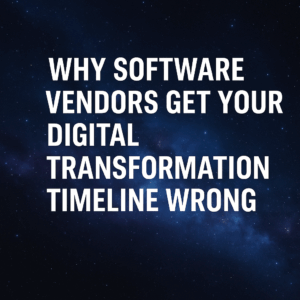Believe it or not, Lean Six Sigma remains crucial to digital transformation success. But what exactly is Lean Six Sigma? This article will delve into that topic.
![What is Lean Six Sigma? [And What It Means For Digital Transformation] 1 YouTube player](https://i.ytimg.com/vi/3TvnZCrR7_o/maxresdefault.jpg)
Two decades ago, Lean Six Sigma was prevalent. Many organizations, especially those in the manufacturing sector, prioritized Lean Six Sigma. It was essential to employ staff that would adhere to Six Sigma methodologies. However, over the years, the prominence of Six Sigma has diminished as new buzzwords and trends have emerged, overshadowing its significance. This article will address two primary topics: first, the definition of Lean Six Sigma, and secondly, how Lean Six Sigma can enhance the effectiveness of a digital transformation.
Table of Contents
ToggleWhat is Six Sigma
To comprehend Lean Six Sigma, it is essential to first understand the Six Sigma concept, and subsequently, the Lean aspect.
Six Sigma is a methodology rooted in statistics, aiming for no more than 3.4 defects per million occurrences. For instance, a manufacturing organization that produces one million widgets should aim to have no more than three defects within that production. It is an ambitious target, reflecting the rigorous standards Six Sigma represents. The concept of Six Sigma was introduced by Motorola in the 1980s as a response to the Kaizen philosophy propagated by Toyota and other Japanese companies. At the zenith of its implementation, Motorola credited over $17 billion in annual savings to its Six Sigma initiatives, underscoring its significance to the company’s operations and long-term success.
Six Sigma’s widespread acknowledgment, particularly in Corporate America, can be attributed to Jack Welch, the former CEO of General Electric. Under Welch’s leadership, General Electric adopted Six Sigma, thereby amplifying its presence, especially within manufacturing entities. Consequently, from the 1990s to the 2000s, Six Sigma gained considerable relevance among global organizations.
![What is Lean Six Sigma? [And What It Means For Digital Transformation] 2 YouTube player](https://i.ytimg.com/vi/bvDlsPiGUD4/maxresdefault.jpg)
What is Lean
While Six Sigma emphasizes defect reduction, Lean concentrates on minimizing inefficiency and waste. Thus, Lean complements Six Sigma’s objective of defect reduction and quality enhancement by addressing the cost and efficiency aspects of operations.
Lean’s primary focus is viewing an organization through the lens of the customer. This perspective was a precursor to today’s emphasis on customer experience, journey, and mapping. Fundamentally, Lean prioritizes continuously seeking opportunities to curtail waste, boost efficiency, and ensure the production of the highest quality outputs for customers at the lowest feasible cost. When Lean’s principles are integrated with those of Six Sigma, the combined methodology is termed Lean Six Sigma.
A cornerstone of Lean Six Sigma is the principle of continuous improvement. This approach encourages perpetual analysis and enhancement of operations, aiming for fewer defects and heightened efficiency throughout an organization. This perpetual improvement is orchestrated using the DMAIC framework, an acronym for Define, Measure, Analyze, Improve, and Control. This cycle involves understanding and analyzing current operations, identifying root causes or problem areas, and emphasizing the reduction or elimination of these inefficiencies or quality issues.
What sets Lean Six Sigma apart is its emphasis on inclusivity. The methodology promotes an environment where all employees, whether they are on the shop floor, in the warehouse, or processing accounting transactions, actively participate. For an initiative to be authentically rooted in Lean Six Sigma, it should encompass every member of the organization. Furthermore, Lean Six Sigma is not a transient strategy; it represents a profound operational change. Rather than being a short-term project, it necessitates a paradigm shift in operations, embedding itself into the very DNA of an organization.
Analytical Tools
Lean Six Sigma is characterized by its analytical and data-driven framework. Instead of merely relying on anecdotal instances or feedback from employees and customers, the foundation of Lean Six Sigma lies in statistical and data analysis. It seeks insights from data to guide improvement measures.
A significant challenge for many organizations is the absence of appropriate technology or tools to gather the requisite data. The capability to collate and then scrutinize this data is crucial for the effective application of Lean Six Sigma.
In addition to its data-centric approach, Lean Six Sigma employs various analytical tools to streamline and optimize organizational processes. For instance, to perform a root cause analysis, there are fishbone diagrams. These diagrams focus on a specific issue or symptom, helping organizations determine its underlying causes. Another tool is SIPOC mapping, an acronym for Suppliers, Inputs, Processes, Outputs, and Customers. This analytical technique offers a comprehensive view of processes from the perspective of customer delivery and all contributing elements. Furthermore, there’s Value Stream Mapping, a method that originated from Lean Six Sigma. This tool aids in identifying the value generated at different stages within an organization, pinpointing areas for cost and waste reduction.
Another beneficial tool, though not traditionally linked with Lean Six Sigma, is process mining. As a relatively recent addition to the market, process mining facilitates data collection from existing systems. This technology is instrumental in determining process efficiency, locating defects, and identifying discrepancies in business operations. For those familiar with business process mining, it serves as an excellent complementary tool for Lean Six Sigma initiatives.
Cultural Impact
One often underestimated element critical to the success of Lean Six Sigma is its organizational and cultural impact. While Lean Six Sigma involves a data-driven approach, an analytical framework, and a commitment to continuous improvement, its influence on the cultural dynamics of an organization is profound. Essentially, Lean Six Sigma represents a complete cultural transformation, underpinned by an unyielding commitment to perpetual enhancement.
Organizational change management is integral to Lean Six Sigma initiatives. Emphasizing the human element is vital to complement the analytical and data-centric aspects. Harmonizing these components magnifies the efficacy of Lean Six Sigma.
Several cultural shifts often arise as a result of implementing Lean Six Sigma. Firstly, there’s an amplified focus on the customer. Organizations that previously oriented their strategies internally are now compelled to view operations from the customer’s perspective, assessing the value being delivered to them. This customer-centric approach constitutes a significant cultural paradigm shift.
Furthermore, Lean Six Sigma fosters a culture of relentless improvement. The underlying philosophy is that there’s always room for enhancement in business operations, promoting a proactive approach to innovation and refinement.
Another pivotal aspect of Lean Six Sigma is its emphasis on the collective commitment of the workforce. The methodology necessitates that frontline employees, as well as a vast majority of the organization, fully embrace the ethos of continuous improvement. For organizations where employees might have previously felt undervalued or excluded from decision-making processes, Lean Six Sigma presents an opportunity for greater inclusivity and involvement in daily operations.
Considering these transformative elements, it’s imperative for organizations to incorporate a comprehensive change management strategy to reinforce their Lean Six Sigma initiative.
![What is Lean Six Sigma? [And What It Means For Digital Transformation] 3 YouTube player](https://i.ytimg.com/vi/Z1ZjEs94F4U/maxresdefault.jpg)
Lean Six Sigma Paths
When considering Lean Six Sigma, there are several avenues available. Firstly, one can acquaint themselves with the diverse tools, frameworks, and methodologies inherent to Lean Six Sigma. This can be undertaken independently or through formal certification. Those seeking structured training can pursue varying degrees of certification: from Green Belt to Black Belt, and even Master Black Belt. Each level represents a distinct depth of knowledge, understanding, and application of Lean Six Sigma.
Another alternative is to engage external expertise. Organizations such as Third Stage Consulting can be enlisted to facilitate the adoption and implementation of Lean Six Sigma strategies, guiding businesses through the initial stages of this journey.
A crucial consideration is the potential application of Lean Six Sigma in digital or business transformations. It serves as a valuable catalyst in business enhancement initiatives. Notably, implementing Lean Six Sigma does not always necessitate substantial technology investments. While some paths might lead to considerable technology expenditure, many solutions within the Lean Six Sigma framework can be cost-effectively implemented using existing technology. This not only maximizes value from current systems but also prepares organizations for potential technological upgrades, ensuring a robust foundational base.
In relation to the application of Lean Six Sigma in digital or business transformations, it’s beneficial to explore how this methodology integrates with broader transformation strategies. Additional resources, encompassing digital and business transformation insights, are provided in the description. These resources aim to guide organizations in effectively leveraging Lean Six Sigma and other industry best practices for successful transformations.
I would enjoy brainstorming ideas with you if you are looking to strategize an upcoming transformation or are looking at selecting an ERP system, so please feel free to contact me at eric.kimberling@thirdstage-consulting.com. I am happy to be a sounding board as you continue your digital transformation journey.





